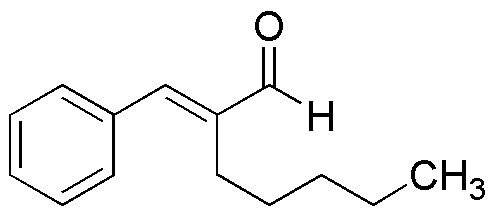a-Amylcinnamaldehyde is widely utilized in research focused on
- Fragrance Industry: This compound is a key ingredient in perfumes and scented products, providing a sweet, warm aroma that enhances the overall fragrance profile.
- Flavoring Agent: It is used in food products to impart a pleasant flavor, particularly in baked goods and confections, making them more appealing to consumers.
- Cosmetics: The compound is incorporated into cosmetic formulations for its aromatic properties, improving the sensory experience of products like lotions and creams.
- Pharmaceuticals: In medicinal chemistry, it serves as a building block for synthesizing various therapeutic agents, contributing to the development of new drugs.
- Research Applications: It is used in studies related to olfactory perception and sensory analysis, helping researchers understand how different compounds interact with human senses.
General Information
Properties
Safety and Regulations
Applications
a-Amylcinnamaldehyde is widely utilized in research focused on
- Fragrance Industry: This compound is a key ingredient in perfumes and scented products, providing a sweet, warm aroma that enhances the overall fragrance profile.
- Flavoring Agent: It is used in food products to impart a pleasant flavor, particularly in baked goods and confections, making them more appealing to consumers.
- Cosmetics: The compound is incorporated into cosmetic formulations for its aromatic properties, improving the sensory experience of products like lotions and creams.
- Pharmaceuticals: In medicinal chemistry, it serves as a building block for synthesizing various therapeutic agents, contributing to the development of new drugs.
- Research Applications: It is used in studies related to olfactory perception and sensory analysis, helping researchers understand how different compounds interact with human senses.
Documents
Safety Data Sheets (SDS)
The SDS provides comprehensive safety information on handling, storage, and disposal of the product.
Product Specification (PS)
The PS provides a comprehensive breakdown of the product’s properties, including chemical composition, physical state, purity, and storage requirements. It also details acceptable quality ranges and the product's intended applications.
Certificates of Analysis (COA)
Search for Certificates of Analysis (COA) by entering the products Lot Number. Lot and Batch Numbers can be found on a product’s label following the words ‘Lot’ or ‘Batch’.
*Catalog Number
*Lot Number
Certificates Of Origin (COO)
This COO confirms the country where the product was manufactured, and also details the materials and components used in it and whether it is derived from natural, synthetic, or other specific sources. This certificate may be required for customs, trade, and regulatory compliance.
*Catalog Number
*Lot Number
Safety Data Sheets (SDS)
The SDS provides comprehensive safety information on handling, storage, and disposal of the product.
DownloadProduct Specification (PS)
The PS provides a comprehensive breakdown of the product’s properties, including chemical composition, physical state, purity, and storage requirements. It also details acceptable quality ranges and the product's intended applications.
DownloadCertificates of Analysis (COA)
Search for Certificates of Analysis (COA) by entering the products Lot Number. Lot and Batch Numbers can be found on a product’s label following the words ‘Lot’ or ‘Batch’.
*Catalog Number
*Lot Number
Certificates Of Origin (COO)
This COO confirms the country where the product was manufactured, and also details the materials and components used in it and whether it is derived from natural, synthetic, or other specific sources. This certificate may be required for customs, trade, and regulatory compliance.

